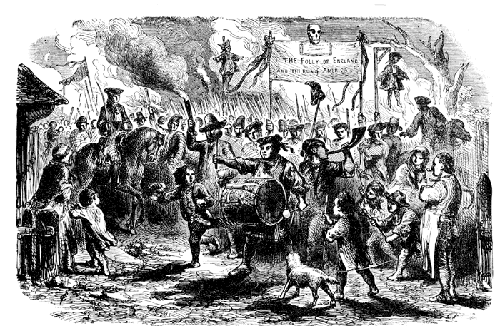The Stamp Act was passed by Parliament in 1765; effectively, it required the colonists to pay a tax, represented by a stamp.
Included under the act were bonds, licenses, certificates, and other official documents as well as more mundane items such as plain parchment and playing cards. It imposed a tax on all papers and official documents in the American colonies, though not in England.
It was a direct tax imposed by the British government without the approval of the colonial legislatures and was payable in hard-to-obtain British sterling, rather than colonial currency.
Further, those accused of violating the Stamp Act could be prosecuted in Vice-Admiralty Courts, which had no juries and could be held anywhere in the British Empire. (Gilder-Lehrman Institute of American History)
The colonists had recently been hit with three major taxes: the Sugar Act (1764), which levied new duties on imports of textiles, wines, coffee and sugar; the Currency Act (1764), which caused a major decline in the value of the paper money used by colonists; and the Quartering Act (1765), which required colonists to provide food and lodging to British troops under certain circumstances.
With the passing of the Stamp Act, the colonists’ grumbling finally became an articulated response to what they saw as the mother country’s attempt to undermine their economic strength and independence.
The first legislative protest against the Stamp Act came from Virginia. On May 30, 1765, the House of Burgesses adopted four resolutions, submitted by Patrick Henry. On the 8th of June, Massachusetts issued the call for the Stamp Act congress.
By November 1, the date on which the Stamp Act was to go into effect, the resolutions of assemblies and public meetings, and the intimidation and violence of the ‘Sons of Liberty’ and others, had made the execution of the act impossible, even if stamps could have been had.
A circular letter from Conway to the governors, dated October 24, urging them to do their utmost to maintain law and order, and authorizing them to call upon the military and naval commanders for assistance, if necessary, was unavailing.
At the opening of Parliament, December 17, papers relating to affairs in America were submitted.
Numerous petitions were also presented setting forth the losses which the Stamp Act had inflicted upon British trade.
A resolution declaratory of the right of Parliament to tax the colonies, submitted February 3, was adopted by large majorities.
On the 6th the Lords, by a vote of 59 to 54, resolved in favor of executing the Stamp Act; but a similar proposition in the Commons was rejected by a vote of more than two to one.
On the 12th the King announced himself favorable to modification of the act; while the examination of Franklin before the House of Commons further strengthened the argument for repeal.
The repeal bill and the declaratory bill passed the Commons March 4, and on the 7th the declaratory bill passed the Lords.
The proposition to repeal the Stamp Act, however, encountered strong opposition in the Lords, where 33 members entered a protest against it at the second reading, and 28 at the third; but on the 17th the bill passed, and the next day both acts received the royal assent.
Parliament appeased the unruly colonists by repealing the Stamp Act. However, the repeal of the Stamp Act did not mean that Great Britain was surrendering any control over its colonies.
The Declaratory Act, passed by Parliament on the same day the Stamp Act was repealed; members of Parliament were upset that colonists had challenged their authority and they asserted complete authority to make laws binding on the American colonies “in all cases whatsoever” and stated that the British Parliament’s taxing authority was the same in America as in Great Britain. (LOC)
The act particularly illustrated British insensitivity to the political maturity that had developed in the American provinces during the 18th century, partly in response to Parliament’s unwritten policy of salutary neglect toward the colonies during the first half of the century. (Select Charters Illustrative of American History)
Click the following link to a general summary about the Declaratory Act:








